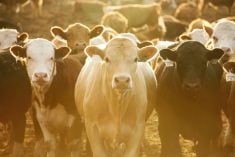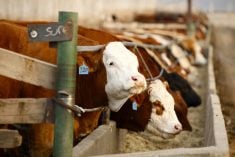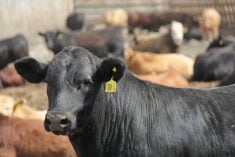Compared to last week, western Canadian yearling prices were unchanged while calves traded $3 lower to $3 higher. Feedlot operators pulled in the reins and realized the market may have overextended itself. Feeder cattle prices are now at levels where margins are negative in the deferred positions.
Order buyers could feel the momentum subside this week just by the number of phone calls. There was instant buyers’ remorse on feature quality groups as the new owner penciled out a charitable donation to the seller. This market behaviour is not uncommon but the nightmares from 2015 and 2016 are still quite fresh. The market was relatively flat across the Prairies. The Alberta reach may have been shortened this past week but eastern Canadian orders sustained the markets in the Saskatchewan and Manitoba.
Read Also

U.S. grains: Soy futures post biggest monthly gain in nearly five years on China trade optimism
U.S. soybean futures climbed to a 15-month high and posted their biggest monthly gain in nearly five years on Friday following a rally fueled by the prospect of revived exports to China.
Quality yearling packages were firm with 875-lb. larger-frame Charolais-based medium-flesh steers trading for $198 in central Alberta; medium-frame red steers holding medium flesh averaging 830 lbs. were quoted at $208 in southern Manitoba. Red and tan thin heifers averaging 840 lbs. were cited at $186 in southern Alberta. Heifers lost ground in the eastern Prairie regions; medium-frame, medium-flesh Angus-cross 846-lb. heifers were quoted at $178 in southern Manitoba.
Calves experienced a mixed tone with noticeable discounts on unweaned bawlers. Compared to last week, buyers become more finicky. Patience was exemplified with larger volumes scheduled to come on the market over the next couple of weeks. Some pockets developed where the market felt vulnerable. In southern Alberta, black semi-weaned steers weighing 675 lbs. were quoted $225 while black heifers weighing 650 lbs. were $196. Unweaned Charolais-cross mixed steers averaging 525 lbs. traded for 242 in central Alberta; mixed thin fresh steers weighing 535 lbs. sold for $237 in southern Manitoba. In central Alberta, mixed fresh heifers weighing just over 500 lbs. sold for $210. Lighter-weight calves under 550 lbs. seemed to trade at a slight premium in Saskatchewan compared to Manitoba and Alberta.
— Jerry Klassen manages the Canadian office of Swiss-based grain trader GAP SA Grains and Produits Ltd. and is president and founder of Resilient Capital, specializing in proprietary commodity futures trading and market analysis. Jerry consults with feedlots on risk management and writes a weekly cattle market commentary. He can be reached at 204-504-8339.












